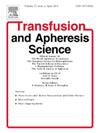The molecular diagnosis and management of rare D--/D-- variants within a family of Iranian descent
IF 1.2
4区 医学
Q4 HEMATOLOGY
引用次数: 0
Abstract
Anti-Hr0 (Anti-Rh17) is an uncommon antibody to high-frequency antigens within the Rh blood group system. It is found in individuals who do not possess the typical antigens of the Rh system, such as those with D--/D-- and Dc–/Dc- phenotypes, particularly after they have been exposed to red blood cells of the prevalent Rh phenotype through pregnancy or blood transfusion. This antibody has impacted numerous expectant mothers, resulting in perinatal fatalities. As a result, prompt and efficient handling of these situations is crucial. We present a case involving a mother with a D-- phenotype who tested positive for anti-Rh17 and subsequently gave birth to an infant exhibiting anemia and elevated bilirubin levels. In the course of this study, the family members were assessed, revealing that four individuals were identified with the D-- phenotype.
伊朗血统家族中罕见D- /D-变异的分子诊断和管理
抗- hr0(抗- rh17)是Rh血型系统中一种少见的高频抗原抗体。它存在于不具有Rh系统典型抗原的个体中,例如具有D- /D-和Dc- /Dc-表型的个体,特别是在他们通过怀孕或输血暴露于流行的Rh表型的红细胞之后。这种抗体影响了许多孕妇,导致围产期死亡。因此,迅速有效地处理这些情况至关重要。我们报告了一个病例,涉及一位D-表现型的母亲,她的抗rh17检测呈阳性,随后生下了一个患有贫血和胆红素水平升高的婴儿。在这项研究的过程中,对家庭成员进行了评估,发现有四个人被鉴定为D-表型。
本文章由计算机程序翻译,如有差异,请以英文原文为准。
求助全文
约1分钟内获得全文
求助全文
来源期刊
CiteScore
3.60
自引率
5.30%
发文量
181
审稿时长
42 days
期刊介绍:
Transfusion and Apheresis Science brings comprehensive and up-to-date information to physicians and health care professionals involved in the rapidly changing fields of transfusion medicine, hemostasis and apheresis. The journal presents original articles relating to scientific and clinical studies in the areas of immunohematology, transfusion practice, bleeding and thrombotic disorders and both therapeutic and donor apheresis including hematopoietic stem cells. Topics covered include the collection and processing of blood, compatibility testing and guidelines for the use of blood products, as well as screening for and transmission of blood-borne diseases. All areas of apheresis - therapeutic and collection - are also addressed. We would like to specifically encourage allied health professionals in this area to submit manuscripts that relate to improved patient and donor care, technical aspects and educational issues.
Transfusion and Apheresis Science features a "Theme" section which includes, in each issue, a group of papers designed to review a specific topic of current importance in transfusion and hemostasis for the discussion of topical issues specific to apheresis and focuses on the operators'' viewpoint. Another section is "What''s Happening" which provides informal reporting of activities in the field. In addition, brief case reports and Letters to the Editor, as well as reviews of meetings and events of general interest, and a listing of recent patents make the journal a complete source of information for practitioners of transfusion, hemostasis and apheresis science. Immediate dissemination of important information is ensured by the commitment of Transfusion and Apheresis Science to rapid publication of both symposia and submitted papers.

 求助内容:
求助内容: 应助结果提醒方式:
应助结果提醒方式:


